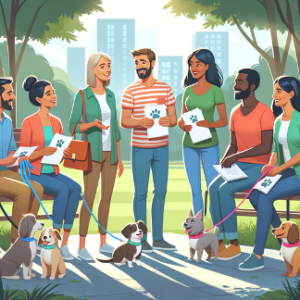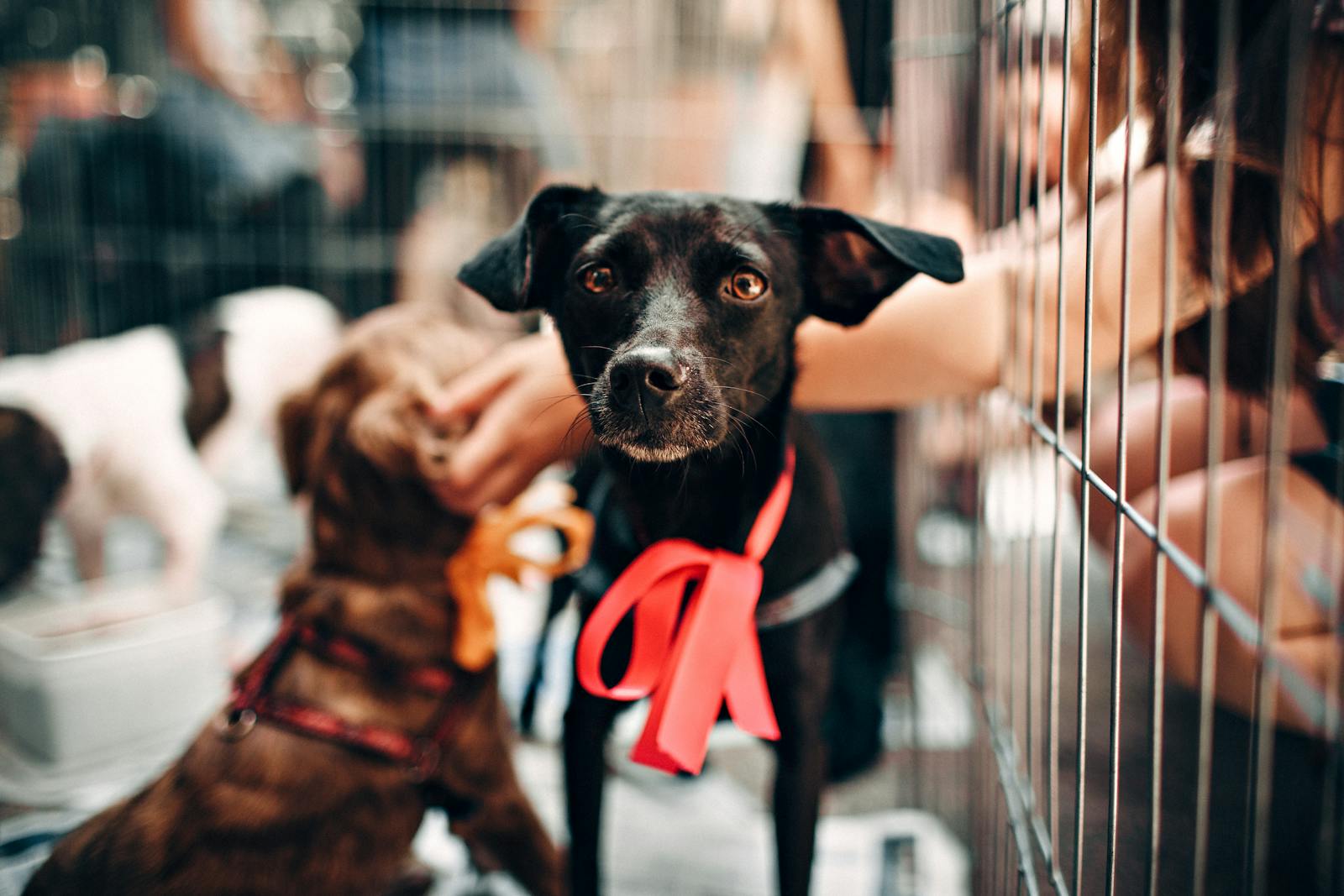How to Ensure Compliance with Local Pet Laws in Your Area
Understanding Local Pet Laws: A Guide for Responsible Pet Owners
As a devoted pet owner, there is nothing more important than ensuring the safety and well-being of your furry friends. However, navigating the complex landscape of local pet laws can feel like a daunting task. With regulations varying significantly from one area to another, it’s crucial to educate yourself on the specific rules that apply to your locality. Understanding these laws not only helps you avoid potential fines or legal issues but also enhances the harmony between your pet and the community.
In this guide, we’ll explore why being aware of local pet laws matters, break down the most common types of regulations, and provide actionable tips on how you can research the specific regulations in your area.
Why Understanding Local Pet Laws Matters
Local pet laws are designed with community safety and welfare in mind. Here are some compelling reasons why you should take the time to understand them:
- Safety for Your Pet: Many laws exist to keep pets safe—like leash laws and pet licensing requirements. Familiarizing yourself with these regulations helps protect your furry companions from harm.
- Legal Compliance: Ignorance of the law is no excuse. If your pet breaks a local ordinance, you could face fines, confiscation, or other penalties.
- Community Relations: Adhering to pet laws fosters goodwill within your neighborhood. It’s essential to be a responsible pet owner and maintain positive relationships with your neighbors.
Common Types of Local Pet Laws
Understanding the common categories of pet laws in your area can simplify your research. Here are some of the most prevalent types of regulations:
1. Leash Laws and Restraint Regulations
- Many municipalities require pets to be leashed when in public spaces. This helps prevent accidents and ensures the safety of both your pet and others.
- Some regions have designated off-leash areas, commonly known as dog parks. Researching your local parks can provide a safe space for your pet to socialize and exercise.
2. Licensing and Vaccination Requirements
- Local governments often mandate pet licensing, which typically requires proof of vaccinations. This regulation helps keep track of pet populations and ensures that animals are vaccinated against rabies and other diseases.
- You may also need to update licenses regularly, so be sure to keep your pet’s documentation current.
3. Noise Ordinances
- Pets, especially dogs, can be noisy, and local laws often address excessive barking. If you find yourself in a complaint situation, understanding such ordinances can guide your response.
- It’s essential to mitigate any excessive noise from your pet to avoid disturbances for your neighbors.
4. Pet Limits and Breed-Specific Legislation
- Some areas may have restrictions on how many pets you can own or on specific breeds that are viewed as dangerous. Familiarize yourself with these limits to avoid unwanted legal issues.
- If your area has breed-specific legislation, you may need to take extra precautions if you own a breed that falls under these regulations.
5. Pet Waste Disposal Requirements
- Most communities require pet owners to clean up after their pets in public areas. Not only is this courteous, but it’s also often mandated by law.
- Keeping portable waste bags handy during walks is a simple yet effective way to comply with these regulations.
Tips for Researching Local Pet Laws
To ensure you are up-to-date with the latest regulations in your area, consider these actionable tips:
1. Visit Local Government Websites
Visit your city’s or county’s official website. Most localities have a section dedicated to animal control or pet laws. Look for documents outlining regulations, ordinances, and any recent changes to existing laws.
2. Consult Your Local Animal Control Agency
Reach out to your local animal control agency for inquiries or clarification on specific laws. They can often provide the most accurate and up-to-date information.
3. Attend Community Meetings
Many cities hold meetings or forums where residents can learn about local laws and issues affecting the community. Attending these gatherings can give you crucial insights and allow you to connect with other pet owners.
4. Engage with Local Pet Groups
Join local pet owner associations or social media groups. These forums are great for sharing information, dispelling myths, and discussing updates regarding pet regulations.
5. Consult an Attorney if Necessary
For more serious concerns or if you’re facing legal action because of pet-related issues, consider consulting with an attorney who specializes in local ordinances.
Conclusion: Be a Responsible Pet Owner
Understanding local pet laws is not just about complying with legal standards; it’s about being a responsible and conscientious pet owner. By educating yourself on the regulations in your area, you’ll not only protect your pets but also create a safer and more enjoyable environment for everyone. Remember, well-regulated pet ownership fosters strong community ties and significantly reduces the likelihood of conflicts arising from misunderstandings.

Research Your Area’s Regulations
Navigating local pet laws is essential for every pet owner, and understanding how to research these regulations thoroughly is just as critical. Here are some effective methods to find and understand the pet laws specific to your area.
1. Visit Local Government Websites
One of the most reliable ways to find accurate information about pet laws is by visiting your local government websites. Most municipalities have dedicated sections for animal control or pet regulations. Here’s how to make the most of these resources:
- Search for Specific Departments: Look for sections like “Animal Control,” “Department of Public Health,” or “City Ordinances.” These sections typically provide detailed information about local laws regarding pet ownership.
- Utilize Search Functions: Don’t hesitate to use the search bar on the website. Enter terms like “pet laws,” “leash laws,” or “animal ordinances” to find relevant documents faster.
- Check for Updates: Some local laws may change, so ensure that you’re reading the most recent documents. Look for a publication date on these pages.
2. Consult Your Local Animal Control Agency
Your local animal control agency is another valuable resource when researching pet regulations. These agencies are often the teams responsible for implementing and enforcing the laws. Here’s how to leverage their services:
- Call or Email for Clarification: Don’t hesitate to reach out if you have specific questions or need clarification about certain regulations. They can provide precise answers and explain complex laws.
- Request Printed Resources: Many agencies offer brochures or pamphlets summarizing local pet laws. These can be handy references to keep at home.
- Inquire About Local Resources: In addition to providing law specifics, animal control agencies often know about local pet-friendly initiatives or community events that support responsible pet ownership.
3. Attend Community Meetings
Many cities host community meetings or forums where residents can engage with local government officials, including those from animal control. Participating in these gatherings can provide a wealth of knowledge about your community’s pet laws:
- Connect with Officials: These meetings are opportunities for direct dialogue with officials implementing pet laws. Ask questions and express any concerns you may have from a pet ownership perspective.
- Network with Other Pet Owners: Connecting with fellow local pet owners can help share resources and insights about pet laws or best practices in compliance.
- Stay Informed on Changes: Community meetings often address emerging issues affecting local laws. Staying updated can help you remain compliant with any new regulations that arise.
4. Engage with Local Pet Groups
Joining local pet owner associations or social media groups can significantly boost your understanding of pet laws while fostering connections with others passionate about animals. Here’s how to make the most of these groups:
- Join Online Forums: Platforms like Facebook have numerous groups where local pet parents share advice and updates about regulations in your area. Search for groups focused on pet ownership or local pet advocacy.
- Participate in Discussions: Engage in conversations about local laws, share experiences, and ask for recommendations. You may find tips on how to navigate specific regulations.
- Collaborate on Advocacy: Such groups often mobilize for community causes, including advocating for better pet laws or improved regulations. Being involved can help shape a more pet-friendly environment.
5. Consult an Attorney if Necessary
Sometimes, it’s wise to seek professional assistance, especially if you face legal concerns or if an incident arises that may involve potential legal action. Here’s when and how to consider this option:
- Assess the Situation: If you’re dealing with complex issues regarding pet regulations, an attorney specializing in animal law can offer insights tailored to your situation.
- Get Recommendations: Either from fellow pet owners or through online directories, make sure to find reputable attorneys who specialize in local ordinances or animal rights.
- Discuss Preventative Measures: Consulting an attorney can be beneficial even if you’re not facing immediate issues. They can help you understand the implications of specific laws and recommend actions to stay compliant.
By employing these methods, you are equipped to effectively research and thoroughly understand the pet regulations in your area. Knowledge of local pet laws not only safeguards your pet’s well-being but also ensures that you play a proactive role in fostering a positive community environment.

Familiarize Yourself with Licensing Requirements
Understanding the pet licensing requirements in your area is a fundamental aspect of responsible pet ownership. While it may seem like a mere formality, licensing your pet comes with numerous benefits that safeguard both your pet and your community. In this section, we will delve into the necessity of pet licensing, the advantages it offers, and step-by-step instructions on how to obtain a license, including any associated fees.
Why Pet Licensing is Necessary
Pet licensing serves several essential purposes, and its significance cannot be overstated. Here are some key reasons:
- Proof of Ownership: A pet license serves as legal verification that you own your pet, which can be particularly useful in cases of disputes or lost animals.
- Reunification of Lost Pets: In the event your pet goes missing, licensing provides local animal control services with your contact information, enabling them to return your pet to you quickly.
- Public Health and Safety: Licensing often requires proof of vaccinations, particularly against rabies. This helps ensure the safety of both pets and people in the community, contributing to a healthier environment.
- Resource Allocation: Licensing fees typically go towards local animal shelters and control services, enabling the community to better manage the pet population and provide necessary services.
How to Obtain a Pet License
Acquiring a pet license is generally straightforward, but the process can vary depending on your locality. Here’s a step-by-step guide to help you navigate through it:
- Check the Requirements:
- Visit your local government website or contact your animal control agency to understand the specific requirements for licensing pets in your area.
- Commonly required documents include proof of vaccinations, identification, and sometimes a spay/neuter certificate.
- Gather Necessary Documents:
- Ensure you have all necessary documents at hand when applying. This can include:
- Proof of rabies vaccination
- Proof of ownership or adoption
- Any other relevant veterinary paperwork
- Fill Out the Application:
- Most localities offer online applications, but you can also typically find hard copies available at animal shelters, veterinary offices, or local government offices.
- Follow any instructions carefully, filling out all required fields to avoid delays.
- Pay the Licensing Fee:
- Fees can range widely based on location and whether your pet is spayed or neutered. Generally, you can expect to pay somewhere between $10 to $50 for the license, with potential discounts for spayed/neutered pets or for senior citizens.
- Payment methods may include cash, checks, or online payment options depending on your local regulations.
- Submit Your Application:
- You can usually submit your application either online, via mail, or in person at designated locations. Make sure to keep a copy of your application for your records.
- Receive Your License:
- Once your application is processed, you will receive your pet’s license, which usually comes in the form of a tag to be attached to your pet’s collar.
- Renew Annually:
- Pet licenses often require annual renewal, so keep track of deadlines and ensure that you maintain up-to-date vaccination records for your pet.
Additional Considerations
While acquiring a pet license is essential, it’s also vital to understand the implications of not licensing your pet. Potential penalties can include fines, difficulty in reclaiming lost pets, and even increased chances of euthanasia at animal shelters.
Additionally, many communities take pet licensing seriously, and periodic checks may occur to ensure compliance. Being proactive can save you from unnecessary hassles and ensure the well-being of your pet.
Conclusion: The Importance of Pet Licensing
Licensing your pet is a crucial responsibility that reflects your commitment as a pet owner. Not only does it provide essential protections for your animal, but it also enhances community safety and welfare. By taking the time to familiarize yourself with your local licensing requirements and ensuring your pet is registered, you play a significant role in fostering a compassionate environment for all pets and their owners.

Stay Informed on Vaccination Requirements
As a responsible pet owner, keeping your furry companions healthy and safe extends beyond walking them on a leash or providing them with proper food; it also encompasses staying informed about vaccination requirements set forth by local laws. Vaccination not only protects the health of your pet but also contributes to community safety by minimizing the spread of infectious diseases.
The Importance of Pet Vaccinations
Vaccination laws are established to ensure that pets are immune to various contagious diseases, which can impact not only the animals themselves but also the human population. Here’s why these laws are crucial:
- Public Health Protection: Vaccines like rabies prevent transmission of serious zoonotic diseases to humans. In many regions, rabies vaccination is mandated because it is often fatal and poses a public health risk.
- Disease Prevention: Vaccines help eradicate or control diseases such as parvovirus, distemper, and kennel cough among dog populations, and feline leukemia among cats. Immunizing pets contributes to herd immunity, safeguarding those pets who may not be able to receive vaccines for medical reasons.
- Travel Regulations: If you plan to travel with your pet, many jurisdictions and countries require proof of vaccination, particularly against rabies. This documentation is vital for smooth travel experiences and to avoid complications during border crossings.
Common Vaccination Requirements for Pets
Vaccination requirements can differ by municipality and even state, but some common vaccinations are typically mandated. Here’s a breakdown of some of the most frequently required vaccinations:
1. Rabies Vaccination
- Legality: Almost all jurisdictions require pets, particularly dogs and cats, to be vaccinated against rabies. Proof of vaccination must often be provided when obtaining a pet license.
- Frequency: Depending on the vaccine type, rabies shots may be required annually or every three years.
2. Distemper and Parvovirus Vaccinations for Dogs
- Importance: Distemper and parvovirus are highly contagious and can be fatal. Vaccinations are usually administered in combination vaccines (DHPP or DAPP).
- Timing: Puppies typically receive these vaccinations in a series starting at 6-8 weeks of age, with boosters every three to four weeks until they are about 16 weeks old.
3. Feline Leukemia and Feline Viral Rhinotracheitis for Cats
- Legal Aspects: Many places require vaccinations for feline leukemia and rabies, especially for cats that may be exposed to the outdoors.
- Booster Shots: These vaccinations are typically given to kittens in multiple doses and require regular boosters in adulthood.
Resources for Keeping Vaccination Records Updated
Staying compliant with vaccination laws is essential for the health of your pet and the community. Here are some effective strategies for keeping vaccination records organized and up to date:
1. Regular Vet Visits
Schedule annual check-ups with your veterinarian. Your vet will remind you about vaccines due for renewal and ensure your pet receives all necessary vaccinations on time.
2. Digital Record Keeping
Utilize online veterinary portals or pet health apps that allow you to store medical records digitally. This can simplify the tracking of vaccination dates and reminders for upcoming shots.
3. Physical Documentation
Keep a physical file of your pet’s vaccination records at home. Include copies of your pet’s vaccine certificates, license registration, and any other relevant health records. This documentation is beneficial not just for complying with local laws but also for emergencies.
4. Pet Insurance Provider Resources
If you have pet insurance, consult with your provider. They often have resources or requirements regarding vaccinations, which can help ensure that your pet stays healthy while maintaining your insurance coverage.
5. Community Veterinary Programs
Participate in community programs that offer low-cost or free vaccination clinics. These events can help you stay compliant without adding financial stress.
Conclusion: Be Proactive About Vaccination Compliance
Keeping your pet’s vaccination records updated is a vital aspect of responsible pet ownership. By understanding the common vaccination requirements in your area and utilizing the resources available, you can protect your pet’s health while contributing to the well-being of the entire community.

Understanding Breed-Specific Legislation
As passionate pet owners, it’s vital to understand the implications of breed-specific legislation (BSL) on our furry companions. Breed-specific legislation refers to laws and regulations that restrict or ban certain dog breeds that are perceived to be dangerous. This type of legislation has sparked controversial debates across the country—raising questions about the effectiveness, ethics, and implications for responsible pet ownership. If you’re considering adopting a dog or even moving to a new area, it’s essential to grasp what breed-specific legislation entails and how it can impact pet ownership.
What is Breed-Specific Legislation?
Breed-specific legislation is designed to address public safety concerns by targeting specific breeds identified as aggressive or threatening. Commonly regulated breeds may include:
- Pit Bull Terriers
- Rottweilers
- Doberman Pinschers
- Chow Chows
- American Staffordshire Terriers
These laws vary significantly by location. Some municipalities may impose outright bans on these breeds, while others may require specific conditions for ownership, such as mandatory muzzling, liability insurance, or special training classes. Understanding these laws is crucial to avoid unintended violations and potential penalties.
The Impact of Breed-Specific Legislation on Pet Ownership
Breed-specific laws can dramatically shape the experience of pet ownership in various ways. Here are some noteworthy impacts:
- Limited Choices: If you live in an area with strict BSL, your choice in dog breeds will be significantly limited. Many potential pet owners may find that the breed they wish to adopt is not permitted in their locality.
- Increased Costs: Owners of regulated breeds might face higher costs due to insurance requirements, fees for special training classes, and other compliance expenses.
- Confusion and Misunderstanding: There is often confusion surrounding what defines a particular breed, leading to wrongful identification and unjust penalties. For instance, a mixed-breed dog may be perceived as a restricted breed, disrupting the owner’s ability to keep their pet secure and safe.
- Social Stigma: Dogs perceived to be in the “dangerous” breed category may face societal discrimination. Dog owners may find themselves socially stigmatized solely based on their pet’s breed, which can impact both the dog’s and the owner’s well-being.
Real-World Examples of BSL
Various cities and regions have implemented breed-specific legislation, which illustrates how these laws can affect owners and pups alike.
- Denver, Colorado: Denver has an outright ban on pit bull breeds, effectively making it illegal for residents to own them. The city argues that this law protects public safety. However, many advocates claim that responsible ownership is a more effective approach than blanket bans.
- Maui County, Hawaii: In Maui County, certain breeds are banned due to high-profile incidents of bites. The legislation has prompted debates over alternative methods to address dog aggression without targeting specific breeds.
- Ontario, Canada: Ontario’s breed-specific ban on pit bulls has spurred public outcry from pet advocates who argue that the legislation is unfair and ineffective at addressing dangerous behavior from any breed.
Encouraging Responsible Pet Ownership
It’s essential for potential and current pet owners to be aware of breed-specific legislation in their areas. Here are actionable tips to help navigate the regulations:
1. Educate Yourself: Research the local laws that pertain to breed ownership in your community. Use city websites or local ordinances to gather pertinent information.
2. Connect with Local Animal Control: Reach out to your local animal control department for clarity on any regulations regarding specific breeds. They can provide invaluable insight into what is allowed and what is not.
3. Be a Voice in Your Community: If you believe that BSL is unjust, consider getting involved in local advocacy groups that promote responsible dog ownership and oppose breed bans.
4. Promote Responsible Dog Ownership: Advocate for laws that focus on responsible ownership rather than targeting specific breeds. Successful training, socialization, and responsible care can effectively manage dog behavior.
5. Foster Positive Relationships: Demonstrating that “dangerous” breeds can also be friendly, well-behaved companions is key. Engaging with neighbors and the community can help alter perceptions.
Conclusion: Awareness is Key
Understanding the implications of breed-specific legislation is vital for responsible pet owners. By familiarizing yourself with the laws specific to your area, you can make informed decisions that prioritize both your pet’s well-being and public safety. As a community, we can work together to advocate for fair and effective pet ownership regulations that protect both our four-legged friends and our families.

Understanding Leash and Containment Laws: Keeping Pets Safely Confined
As an extension of our previous discussion on local pet laws, it’s vital to delve into specific regulations that deal with leash requirements and containment laws. These regulations play a significant role in enhancing not only the safety of your pets but also the peace of mind for you and your neighbors. By understanding leash laws and the importance of confining pets within your property, you’ll be better equipped to meet legal standards and avoid potential issues that may arise from noncompliance.
The Importance of Leash Laws
Leash laws are primarily established to ensure the safety of pets and the public. Here are some key reasons why adhering to these regulations is essential:
- Preventing Accidents: A dog off-leash can easily cause accidents, whether it’s running into traffic or startling another person or animal. Leash laws help mitigate these risks.
- Encouraging Responsible Pet Ownership: By requiring pet owners to control their animals in public spaces, leash laws promote a culture of responsibility among pet owners.
- Protecting Wildlife: In areas where wildlife is prevalent, leashed pets are less likely to chase or harm local animals, maintaining the ecological balance.
For example, in many urban areas, failing to adhere to leash laws can result in substantial fines—often ranging from $50 to $500, depending on the severity of the violation. If your dog is involved in an altercation with another pet while off-leash, you may face legal repercussions that could lead to civil liabilities.
Containment Regulations: Keeping Pets Safe at Home
Containment regulations are just as crucial as leash laws. These laws typically govern how pets must be confined within private properties. Ensuring that your pets are securely contained can prevent numerous issues:
- Avoiding Escape: Pets that are allowed to roam freely can easily become lost or injured. Proper containment methods, such as secure fencing and gated areas, can keep your pets safe.
- Reducing Conflicts: Uncontained pets can stray into neighbors’ yards or even onto busy roads, leading to conflicts and potential accidents. A securely contained pet provides peace of mind to you and your neighbors.
- Legal Compliance: Many local jurisdictions have specific containment requirements. Not adhering to these can lead to fines or even the confiscation of your pet.
For instance, a dog that frequently escapes and causes disturbances may lead to complaints from neighbors, and the pet owner could face fines or court summons for nuisance behavior if the dog is not adequately contained.
Common Violations and Their Consequences
While most pet owners strive to adhere to leash and containment laws, violations still occur. Here are some common scenarios along with their potential consequences:
1. Roaming Pets
- Violation: Allowing your pet to roam freely outside of your property.
- Consequence: Fines can range from $100 to $2,000, depending on local laws, particularly if the pet causes injury or damage.
2. Off-Leash Pets in Prohibited Areas
- Violation: Exercising your dog off-leash in a designated on-leash area.
- Consequence: Citations for off-leash violations usually result in fines and a record of the incident with animal control agencies.
3. Inadequate Fencing or Containment
- Violation: Failing to provide a proper physical barrier to contain your pets.
- Consequence: Owners may face fines as well as mandatory assessments on pet ownership suitability from animal control agencies.
4. Repeated Violations
- Violation: History of recurring leash law or containment violations.
- Consequence: Multiple offenses may lead to increased fines and possible civil suits if complaints escalate.
Practical Tips for Responsible Leash Use and Containment
Taking responsibility for your pet’s safety means actively complying with leash and containment regulations. Here are some actionable tips:
- Always Use a Leash in Public: Even if your pet is well-trained, it’s best to keep them leashed when in public spaces. Use a sturdy harness and a leash of adequate length for control.
- Regularly Inspect Your Fence: Ensure that your property is adequately fenced and the gates are secure. Even small gaps can be an escape route for curious pets.
- Educate Other Family Members: Ensure that everyone in your household understands the importance of leash laws and how to properly contain your pets.
- Provide Enrichment: Pets that are mentally stimulated through regular exercise and play are less likely to seek adventure outside their containment area.
- Know the Laws: Regularly check local laws as regulations can change. This helps you stay informed and proactive in your pet ownership responsibilities.
Conclusion: Prioritize Pet Safety and Compliance
As a responsible pet owner, knowing and understanding leash and containment laws is vital for the safety of not only your pet but also the community at large. By remaining compliant with these regulations, you’re ensuring that your pet remains safe and that you contribute to a harmonious environment.

Stay Aware of Pet Waste Cleanup Laws
As a responsible pet owner, understanding the laws requiring pet waste cleanup in public spaces is critical. Not only does following these regulations ensure compliance with local ordinances, but it also contributes to community cleanliness and fosters a positive environment for everyone.
Why Pet Waste Cleanup Laws Exist
Pet waste cleanup laws are implemented for several important reasons:
- Public Health: Animal waste can harbor bacteria and parasites that pose health risks to both humans and other animals. By cleaning up after pets, you are minimizing these health hazards.
- Environmental Protection: Pet waste is also a pollutant that can contaminate waterways, affecting the local ecosystem. Responsible disposal helps protect the environment.
- Community Aesthetics: Nobody likes walking through a park or neighborhood littered with pet waste. Keeping public spaces clean enhances the quality of life for all residents.
Understanding your local laws regarding pet waste is not just about avoiding fines; it’s about being a good neighbor and pet owner.
Key Regulations You Should Know
- Clean-Up Requirements:
- Most municipalities require pet owners to clean up after their animals in public spaces, such as parks, sidewalks, and common areas. Failing to do so can result in fines, often ranging from $50 to $500, depending on local ordinances.
- Some areas even have specific signage indicating cleanup laws, making it essential to pay attention to these details in your community.
- Designated Pet Waste Stations:
- Many communities provide pet waste stations equipped with waste bags and disposal bins. Familiarize yourself with the locations of these stations in your area to ensure proper disposal.
- If your community has a pet waste station, use it! It’s a convenient option that ensures proper disposal without extra hassle.
- Fines and Penalties:
- Understanding the fines associated with failing to clean up after your pet can serve as a deterrent. While the specific penalties vary, the potential consequences can impact your budget and community standing.
- In some cases, repeated offenses may lead to more serious penalties, including the possibility of animal control intervention.
Best Practices for Responsible Pet Waste Disposal
- Always Carry Waste Bags:
- Make it a habit to carry biodegradable waste bags whenever you take your pet outside. This simple action ensures that you are always prepared to clean up after your animal.
- Consider investing in a waste bag dispenser to attach to your leash, making it easy to access bags at a moment’s notice.
- Establish a Routine:
- Create a routine for pet walks that includes designated times and places for waste disposal. Teaching your pet to ‘go’ in specific areas can make cleanup easier and more manageable.
- After your pet has relieved itself, always take a moment to ensure the area is clean before you move on.
- Educate Other Pet Owners:
- Engage in conversations with fellow pet owners about the importance of cleaning up after pets. A community that prioritizes cleanliness often has happier residents and pets.
- If you notice other pet owners neglecting their responsibilities, consider offering friendly reminders about the local laws and community expectations.
- Report Issues:
- If you observe local parks or areas lacking proper disposal facilities, report your concerns to local authorities. Public feedback can lead to improvements in community resources.
- Lone instances of uncollected pet waste can snowball into larger community issues. Reporting these problems can aid in finding solutions that benefit everyone.
- Choose Eco-Friendly Options:
- When selecting waste bags, opt for biodegradable options that break down in landfills more quickly than traditional plastic bags. This small change reduces your environmental footprint.
- Additionally, some products are designed to dissolve the waste, making the process even more eco-friendly.
Conclusion: Be A Champion for Community Cleanliness
Being a responsible pet owner goes hand-in-hand with adhering to pet waste cleanup laws. By understanding your local regulations and following best practices for waste disposal, you are not only ensuring a healthier environment for everyone but also setting a positive example within your community.
Remember, a clean neighborhood is a happy neighborhood.

Follow Noise and Behavior Regulations
As we delve deeper into understanding local pet laws, one of the most crucial areas to address are noise and behavior regulations that specifically pertain to pets. These laws are not only designed to maintain peace within the community but also to ensure the safety and well-being of pets. Excessive barking, aggressive behavior, and other disturbances can lead to complaints from neighbors and unnecessary tension among community members. Here, we will explore how to navigate these regulations effectively, provide actionable tips to minimize noise and behavioral complaints, and reinforce good community relations.
Understanding Noise Ordinances
Noise ordinances vary by locality, but most cities have regulations in place that address excessive noise, particularly from pets. The intention behind these laws is clear: ensuring that residents can enjoy their homes without disruptive sounds, including barking dogs. Here’s what you need to know.
Common Noise Ordinance Guidelines
- Barking Limits: Many cities define specific times when excessive dog barking is prohibited. For instance, a common ordinance may state that barking cannot exceed a certain duration or decibel level, especially during late-night hours.
- Reporting Noise Complaints: Typically, if noise becomes a persistent issue, neighbors can file a complaint with local authorities. This could lead to warnings, fines, or even the requirement to relinquish a pet if issues are not resolved.
- Designated Quiet Hours: Most communities have designated quiet hours, often running from 10 p.m. to 7 a.m., during which loud noises—including barking—are subject to stricter regulations. It’s essential to be aware of these times to avoid potential violations.
Mitigating Excessive Barking
As a responsible pet owner, there are several proactive steps that you can take to mitigate excessive barking and prevent complaints from your neighbors. Implementing these strategies can significantly improve your pet’s behavior and your community relations:
1. Training and Socialization
- Enroll in Obedience Classes: Consider professional training for your dog, focusing on reducing barking. Training not only teaches your dog proper behavior but can also relieve boredom, a common barking trigger.
- Socialize Your Pet: Gradually introduce your dog to different environments, sounds, and other pets. This exposure can help decrease anxiety or territorial barking.
2. Mental Stimulation and Exercise
- Regular Walks: Ensure your dog gets ample physical exercise through daily walks. A tired dog is less likely to bark excessively out of boredom or frustration.
- Interactive Toys: Invest in toys that challenge your dog mentally, which can distract them from potential barking triggers. Puzzle toys, for instance, can keep your dog occupied and stimulated.
3. Create a Comfortable Environment
- Safe Space: Create a designated area in your home where your dog feels safe and secure. This can be particularly helpful during noisy times, such as thunderstorms or fireworks, which may provoke unwanted barking.
- Calm Background Noise: Playing soft, soothing music or leaving a TV on at a low volume may help mask noises from outside that could provoke barking.
Understanding Behavioral Regulations
Beyond noise, behavioral regulations surrounding pets often focus on aggressive behavior, which can pose safety concerns for other pets and community members. Here’s what you should be mindful of regarding your pet’s behavior.
Key Behavioral Guidelines
- Leash Laws: Many jurisdictions require pets to be leashed in public spaces. This prevents your pet from approaching others in an aggressive or uncontrolled manner, ensuring everyone’s safety.
- Bite Regulations: Local laws often have stringent penalties for pets that display aggressive behavior or bite individuals. Understanding this aspect of the law can help you train your pet effectively and prevent incidents.
Promoting Good Community Relations
Maintaining positive relationships with your neighbors is crucial not only for a harmonious living environment but also for being responsible pet owners. Here are effective ways to enhance your community standing:
1. Communicate with Neighbors
- Notify Neighbors of Situations: If your dog is prone to barking, inform your neighbors about this, especially if you have plans to be away. Open communication can foster understanding.
- Build Relationships: Engage with your neighbors, and ask them how they feel about pet noise or behavior in your area. Most people appreciate a proactive approach.
2. Participate in Community Events
- Join Local Pet Clubs: Becoming involved in local pet or community groups fosters relationships with other pet owners. This can also keep you informed about local issues affecting pet ownership.
- Attend Neighborhood Meetings: Stay abreast of any community discussions regarding pet regulations. Participating in these meetings can provide insights on how your behavior impacts your neighbors.
3. Be an Advocate for Responsible Pet Ownership
- Share Resources: If you find effective ways to manage noise and behavior issues with your pet, share these tips with fellow pet owners in your community.
- Promote Positive Behavior: Encourage community efforts that address responsible pet ownership, such as pet training workshops. These initiatives can improve the overall perception of pets in the community.
Conclusion
By understanding noise ordinances and behavior regulations concerning pets, you can foster a peaceful and respectful relationship with your neighbors while ensuring the well-being of your pets. Proactive training, effective communication, and community engagement will significantly enhance your experience as a pet owner.

Engage with Local Pet Communities
As a responsible pet owner, one of the best ways to stay informed about local pet laws and regulations is by actively engaging with your local pet community. Building connections with fellow pet owners not only helps you gather valuable information but also fosters a sense of belonging and support. Here are some practical tips on how to effectively engage with your local pet community:
1. Visit Dog Parks Regularly
Dog parks serve as perfect venues for meeting fellow pet owners. They are often hotspots for discussions about the latest regulations, anecdotes about local law enforcement experiences, and shared advice on pet care. By regularly visiting these parks, you can establish relationships that empower you with the knowledge of pending or recent changes in local laws.
2. Join Pet Clubs and Organizations
Consider becoming a member of local pet organizations or clubs. These groups often have newsletters or online forums where members discuss pertinent issues, including changes in local pet laws. Additionally, organizing events that highlight responsible pet ownership can keep everyone informed and engaged.
3. Follow Local Pet Groups on Social Media
Social media platforms are treasure troves of information. Join local pet-related groups on networks like Facebook or Instagram. Here, you’ll find a community eager to share experiences, provide updates on regulations, and even advise on navigating common issues pet owners face. It’s a dynamic avenue for both news and networking.
4. Attend Community Workshops or Seminars
Many local municipalities or animal organizations host workshops or seminars focused on pet ownership. These events can provide insight into local laws and regulations, as well as best practices for responsible pet ownership. You’ll also get the chance to meet others who are passionate about pet care, creating a network of allies within your community.
5. Read Local News Sources Regularly
Staying informed about changes in pet laws can often be as simple as reading your local newspaper or subscribing to local news outlets. Many publications cover topics related to pet ownership, including upcoming legislation, community discussions, and events. By making it a habit, you can stay informed about how regulations may affect you and your pets.
Conclusion: Connect with Your Community
Engaging with local pet communities is not just beneficial—it’s essential for becoming a well-informed pet owner. By connecting with your neighbors, utilizing online resources, and actively participating in local events, you will strengthen your understanding of local pet laws and create a supportive network of fellow pet lovers.
news via inbox
Nulla turp dis cursus. Integer liberos euismod pretium faucibua





